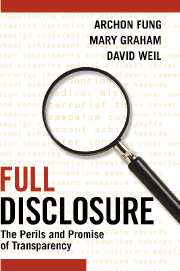Book contents
- Frontmatter
- Dediaction
- Contents
- List of Figures and Tables
- Preface
- 1 Governance by Transparency
- 2 An Unlikely Policy Innovation
- 3 Designing Transparency Policies
- 4 What Makes Transparency Work?
- 5 What Makes Transparency Sustainable?
- 6 International Transparency
- 7 Toward Collaborative Transparency
- 8 Targeted Transparency in the Information Age
- Appendix: EighteenMajor Cases
- Notes
- Bibliography
- Index
8 - Targeted Transparency in the Information Age
Published online by Cambridge University Press: 27 July 2009
- Frontmatter
- Dediaction
- Contents
- List of Figures and Tables
- Preface
- 1 Governance by Transparency
- 2 An Unlikely Policy Innovation
- 3 Designing Transparency Policies
- 4 What Makes Transparency Work?
- 5 What Makes Transparency Sustainable?
- 6 International Transparency
- 7 Toward Collaborative Transparency
- 8 Targeted Transparency in the Information Age
- Appendix: EighteenMajor Cases
- Notes
- Bibliography
- Index
Summary
In November and December 2004, surgeons at Duke University's respected hospitals operated on thirty-eight hundred patients with instruments mistakenly cleaned in hydraulic fluid. The fluid had been drained fromelevators and placed in containers that became mixed up with cleaning supplies.
Shocking? Yes. But unprecedented? Unfortunately, no. Six years earlier, the national Institute of Medicine had informed the American public that medical mistakes were common, even at good hospitals, and that they were often deadly. According to the institute report, every year at least forty-four thousand Americans died and nearly a million were injured by mistakes in hospitals – not counting those killed or injured by mistakes in clinics or doctors’ offices. That made such errors the eighth leading cause of death in the United States, surpassing auto accidents, breast cancer, and AIDS – and the only major source of accidental fatalities not reported to the public. Even patients and their families often were not informed about mistakes when they occurred.
The institute's committee recommended immediate action to reduce medical mistakes by 50 percent in five years. But what policies would encourage hospitals to take steps to minimize such risks? New national rules probably wouldn't help because mistakes, their causes, and their settings were so variable. Instead, the committee recommended a new transparency system. Their report urged Congress and state governments to require hospitals to publicly disclose errors that caused death or serious injury. Disclosure would empower patients to choose safer hospitals. Patients’ changed choices would create new incentives for hospital managers to reduce errors.
However, six years after the institute's urgent call for transparency, virtually all information about deaths and injuries from medical errors remained locked in hospital files – if it was collected at all. The few states that mandated disclosures concerning physician and hospital quality restricted that information to a narrow set of outcomes or did not make information available when and where patients needed it. New York and Pennsylvania laws, for example, required disclosure only of events related to cardiac bypass surgery.
Why had the institute's proposal failed to gain traction? The short answer is that it was swamped by conflicting political interests. Congress and the states failed to act after groups representing doctors and hospitals, including the American Medical Association and the American Hospital Association, formed a coalition to defeat transparency proposals.
- Type
- Chapter
- Information
- Full DisclosureThe Perils and Promise of Transparency, pp. 170 - 182Publisher: Cambridge University PressPrint publication year: 2007
- Creative Commons
- This content is Open Access and distributed under the terms of the Creative Commons Attribution licence CC-BY-NC 4.0 https://creativecommons.org/cclicenses/



